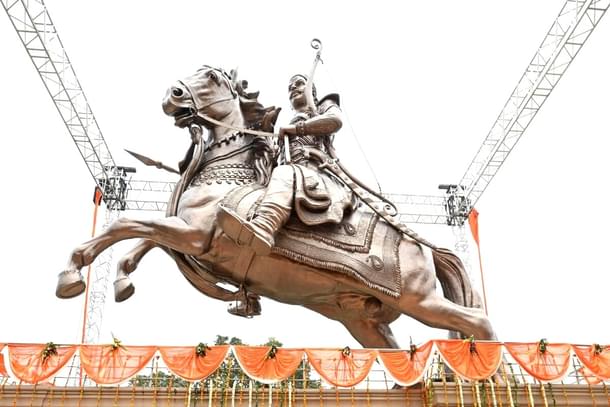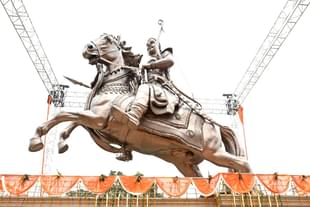Commentary
As Maharaja Suheldev Rises In Bronze, India Begins To Bury The Legacy Of Its Invaders
Shivansh Mishra
Jun 13, 2025, 07:05 PM | Updated 07:24 PM IST
Save & read from anywhere!
Bookmark stories for easy access on any device or the Swarajya app.


Imagine a 40-foot bronze warrior on horseback, gleaming in the Uttar Pradesh sun – this is Maharaja Suheldev, whose recently unveiled monument in Bahraich by Chief Minister Yogi Adityanath, alongside Rs 1,243 crore in development projects, is a thunderclap announcing a new era. It’s India assertively reclaiming its rightful heroes and reshaping a history that was too often written to sideline its true champions.
This builds on Prime Minister Narendra Modi's earlier initiative for the Suheldev Memorial, a national vow to honour the king who crushed the invader Ghazi Saiyyad Salar Masud. Bahraich, for centuries paradoxically famous for Salar Masud's dargah and mela – a celebration of an aggressor – is now turning its face towards its true protector.
Suheldev, the 11th-century King of Shravasti, delivered a crushing blow to Masud's invading hordes at the Battle of Bahraich in 1034 CE, a feat that halted the Ghaznavid advance for a significant period. Known by various names and revered by communities like the Rajbhars and Pasis, his story, once on the peripheries, now rightfully positions him as a pan-Hindu icon who defended Dharma and the motherland.
Yet, how could such a monumental figure be sidelined?
CM Adityanath points to past regimes, accusing them of neglect born of vote-bank politics and a reluctance to celebrate those who resisted invaders.
Suheldev's story was primarily filtered through the Mirat-i-Masudi, a 17th-century text focused on Salar Masud, the very invader Suheldev defeated, until efforts by the Arya Samaj and later political forces began to pull his legend from obscurity. This "erasure" was no accident; it was a suppression that the current leadership aims to rectify, restoring national pride.
The Myth of Salar Masud
The carefully constructed image of Salar Masud Ghazi as a "saint" crumbles under historical scrutiny. What emerges is a military commander of the Ghaznavid invasions, his path marked by shattered temples, brutalised populations, and forced conversions.
Historical records link Masud to the infamous sack of Somnath and savage campaigns across North India. His very title, "Ghazi," signifies a warrior in a religious war against non-believers, not a benign spiritual leader.
The primary text propping up his saintly image, the Mirat-i-Masudi, is not a contemporary record but a 17th-century hagiography by Abdur Rahman Chishti, penned nearly six centuries after Masud's death, designed to idealize, not to accurately record. Crucially, contemporary Ghaznavid chronicles are silent about him, casting immense doubt on the Mirat-i-Masudi's claims.
Scholars like Shahid Amin have shown how such texts helped "domesticate" the brutal memory of conquest, transforming a warlord into a "warrior saint" – a narrative engineering that misled generations.

For centuries, Salar Masud's dargah in Bahraich drew both Muslim and Hindu devotees, a phenomenon often lauded as "syncretic harmony". But this harmony came at the cost of venerating an aggressor, a legacy institutionalised by rulers like Firoz Shah Tughlaq.
Local folklore further embellished this myth, sometimes even depicting Hindu deities as subservient to Masud, subtly manipulating local beliefs. This "domestication of conquest" papered over historical wounds by distorting truth.
Correcting the Narrative
The message from the Uttar Pradesh government is now unequivocal: the era of glorifying invaders is over. The ban on the Jeth Mela at Salar Masud's dargah, and similar actions, are declarations of national self-respect.
Chief Minister Yogi Adityanath has been emphatic: "Freedom from the slave mentality means a complete ban on events held in the name of Salar Masud," identifying him as an "invader and lootera (plunderer)." Bahraich, he declared, belongs to Suheldev, its defender, not Masud, its attacker; major events will now celebrate Suheldev and other local revered figures.
Proposals for an annual 'Vijayotsav' (Victory Festival) for Suheldev and naming institutions after him are about re-sanctifying the land in the name of its true heroes. This is part of a larger imperative: to awaken to our true champions.
Maharaja Suheldev stands in a long, proud line of ancient and medieval Hindu rulers who were the shield of Bharat, defending its Dharma and sovereignty.Their stories, too often buried or twisted, must be unearthed.
The Hindutva perspective correctly identifies a long struggle where Hindu civilization faced existential threats, necessitating a powerful reassertion. Glorifying figures like Chhatrapati Shivaji Maharaj and Maharana Pratap reflects this deep nationalist understanding. The current drive to honor Suheldev and other indigenous heroes is about weaving an unbroken thread of resistance, establishing that the soul of India lies in this age-old fight for freedom.
Suheldev's Legacy
For too long, historical narratives either lionised invaders or downplayed Hindu resilience. This systematic distortion, this "twisting of facts against Hindus," is now being decisively corrected. By reclaiming local heroes like Suheldev and integrating them into the national Hindutva narrative, we connect with histories previously "ignored by the mainstream".
This is part of a larger movement to "decolonise" Indian history, freeing it from biases that belittled Hindu perspectives and achievements. It’s a journey from acknowledging historical victimhood to celebrating a victorious reclaiming of truth and national pride. The resurgence of Maharaja Suheldev is about forging a new Indian consciousness – proud, self-aware, and rooted in the valor of our own.
As CM Yogi Adityanath declared, "History may have done injustice to him (Maharaja Suheldev), but this double-engine government will not allow it".
Memorials and dedicated institutions are ensuring his story inspires generations. Suheldev's saga is a clarion call to defend our heritage.
By dismantling manipulated narratives that praised invaders while ignoring heroes like Suheldev, India is building a "New India" – confident, and anchored in the timeless courage exemplified by Maharaja Suheldev.
Shivansh Mishra writes on law, governance, and politics. He brings a grounded perspective shaped by close engagement with legal research and political processes.





